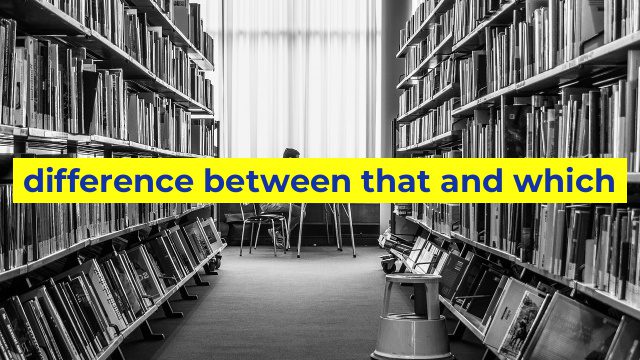The Difference Between That and Which: Understanding Their Usage in Writing
Introduction
As a writer or student, you may have come across the words “that” and “which” while constructing sentences. Though they are both pronouns, they are not interchangeable. It is essential to understand the difference between that and which to avoid incorrect usage and miscommunication.
Usage of “That”
“That” is a restrictive pronoun that is used to introduce essential information to a sentence. It refers to a specific thing or person that is necessary for the meaning of the sentence. For example, “The laptop that has the black cover” specifies a unique laptop with a particular feature.
In most cases, it is used to indicate that the information is critical to the conversation, and its absence would create a different meaning. Using “that” in a sentence ensures that the intended meaning is expressed.
Usage of “Which”
On the other hand, “which” is a non-restrictive pronoun that is used to introduce additional information to a sentence. It refers to something that is not essential to the meaning of the sentence but provides supplementary details. For instance, “The laptop, which has a black cover, has a warranty” provides additional information about the laptop, but the warranty is the main focus.
“Which” is often used in non-defining clauses and is set apart by commas. It can also be preceded by a preposition such as in, on, or at. However, you can only use “which” when there is a preceding noun to relate to.
Examples of Correct Usage
Correct use of “that” and “which” can have a significant impact on the sentence’s meaning. Let’s look at some examples below:
1. The car that I bought last month is blue. (correct)
2. The car, which I bought last month, is blue. (correct)
3. The phone which is in my pocket is new. (incorrect)
4. The phone that is in my pocket is new. (correct)
In example number one, the use of “that” indicates that it is a specific car and not any other car. Number two uses “which” to provide additional information about the car, and it would be correct to have omitted “which” if the information provided was not necessary.
Example three is incorrect because “which” is used when there is no preceding noun to relate to. Finally, example four is correct because “that” is used to introduce unique information needed for the sentence.
Conclusion
In conclusion, the difference between “that” and “which” lies in the level of importance of the information they provide in a sentence. “That” provides essential information about the subject, while “which” provides additional information that is not crucial to the meaning. Understanding how to use them will enhance the clarity and effectiveness of your writing.
Table difference between that and which
As an AI language model, I assume you are asking about the difference between “that” and “which” in grammar.
“That” is a relative pronoun that is used to introduce a restrictive clause. This means that the clause it introduces is essential to the meaning of the sentence, and without it, the sentence would not make sense. For example, “The book that I read yesterday was fantastic” – the information provided by the clause “that I read yesterday” is essential for identifying which book is being referred to.
“Which” is also a relative pronoun, but it is used to introduce a non-restrictive clause. This means that the clause it introduces provides additional information about the subject, but is not essential to the meaning of the sentence. For example, “The book, which I read yesterday, was fantastic” – the additional information provided by the clause “which I read yesterday” is not essential to identify the book being referred to, it simply provides additional context.
The difference in usage can be summarized as follows:
– “That” introduces a clause that is essential to the meaning of the sentence.
– “Which” introduces a clause that provides additional information, but is not essential to the meaning of the sentence.

